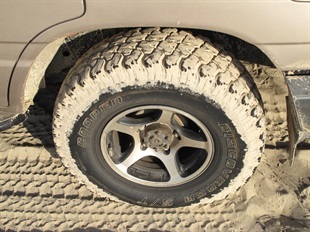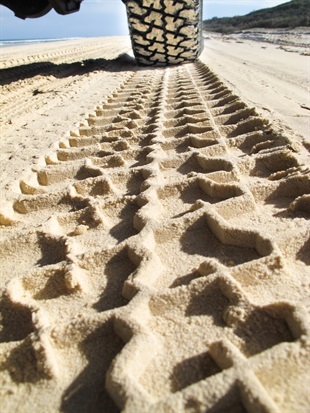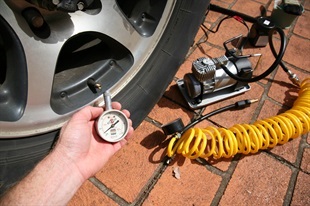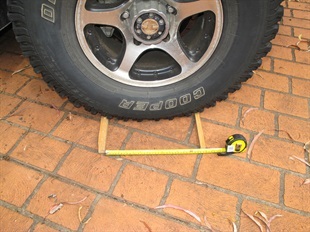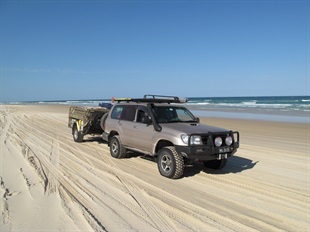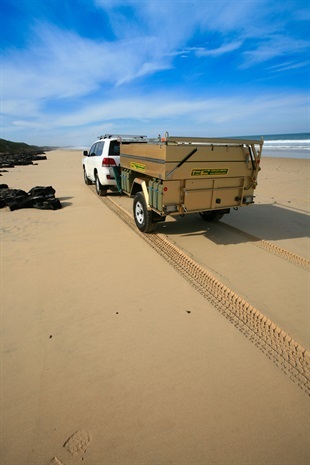The Keys to Successful Sand Driving
Guest blog by Mark Allen
Sun, sand and summer go hand-in-hand, and on a hot day there’s nothing like heading to the beach and getting some ocean breeze on your face as you cruise along with the windows down. But if the beach is unfamiliar territory for you as a driver, the dream of smooth sailing over fine white sand could easily become the sticky, sweaty reality of shovel-work and recovery. Experienced photo journalist and 4WDer Mark Allen gives us expert tips on how to avoid that.
Momentum and Tyre Pressures Are the Key to Success in the Sand
Sand driving can be a heap of fun, yet will undoubtedly have first-timers trembling at the initial ‘launch’ into the soft stuff for fear of becoming forever stuck.
Be sure to load the correct tools for the job into your 4WD: tyre pressure gauge, air compressor and basic recovery gear – a shovel, snatch strap and rated bow shackles are the minimum, with perhaps sand tracks and an air bag jack as extras.
Before setting foot (or tyres) onto the beach, ensure you drop your tyre pressures. While there is no hard and fast rule with minimum pressures, it all depends on your vehicle and how heavy it is; 18 – 20 psi will get most 4WDs over most sand. Dropping down lower is doable, provided safe driving techniques are adhered to: low speeds and no sudden or hard turns as rolling a tyre off the rim is easily done.

There really is no need to drive overly fast on soft sand. Momentum is the way to go – not too slow and not too fast. Once you’ve decided the path you’re going to take, do it without doubt of hesitation as pausing at the wrong time could see your vehicle sink into the softer sand. Once your 4WD is bellied out, there is little hope of easily driving out. It’ll be time for the shovel to dig a path (in front or behind) your tyres, as well as clearing the sand away from underneath.
At times following others’ tyre tracks may provide for an easier path as you’ll be driving in slightly more compacted sand. Sometimes this can also lead to your 4WD dragging it’s belly on the sand if the tracks are too deep, so every situation is different and you’ll have to learn to ‘read’ the tracks ahead. Be sure to inspect under your vehicle before doing any 4WDing, so you know how high or low the major components are.
Don’t be too concerned about allowing your 4WD to wander around a little following other tracks. Instead of a nice straight line, you’ll tend to ‘tramline’ your way from side-to-side as your tyres ‘bounce’ off others’ wheel ruts. Keep a grip on the steering wheel, but don’t keep recorrecting or fighting the wheel as you snake your way through the softer sand.
Don’t be too hard on the brakes. Rather, allow your 4WD to decelerate slowly with a gentle dab of the brakes or your 4WD may bog down, making the next take-off difficult. When you do come to a complete stop, always try to ensure you’re facing downhill to make the next take-off easy.
Never attempt to drive a sand dune diagonally or sideways. Either tackle them straight up or down, or not at all. If you don’t make it to the top of a dune, simply reverse directly down for a retry or take a different route.
Each different 4WD (size, weight, diesel, petrol, powerful or not) will dictate whether to use low or high range. You’ll need to choose a gear that’ll allow for the correct speed and power outputs to get you through the softer sections of sand. Automatic transmissions overcome some of the guesswork, provided you don’t overheat them via torque converter slippage in very soft sand. That’s why low range is particularly useful (manual or auto transmission) to make full use of that low gearing and extra power outputs. You’ll have to perform some quick changes in a manual if you do sense a loss of power; preferably, change down sooner rather than later.
A second vehicle is always useful to have along to help if one of you should get stuck, so talk a mate into coming along with you on your first sand adventure and give it a go, you’ll love it. Just remember to reinflate your tyres when you’ve finished playing on the beach!
Trailers
While most will know a guide for tyre pressures on your 4WD while beach driving, there’s not a lot written about the poor old camper trailer or caravan tyre pressures. As with your 4WD’s tyre pressures, there is no hard and fast rule for whatever it is you’re towing either, so here’s a simple way to get you started.
1) Lower your 4WD’s tyre pressures to the required pressures.
2) Measure the length of your 4WD’s tyre tread touching the ground at the lowered pressure. See photo for an easy way with 2 sticks and a tape.
3) Lower your trailer’s tyre pressures until you achieve the same measured length in step 2 above.
4) Take note of the pressure in your trailer’s tyre that has resulted in the required tyre contact length and hey presto, you’ve got a pressure to lower to for next time!
Now you’ve got a good starting pressure to go off road while towing a trailer, but don’t be scared to alter the pressures a bit. This trick will help greatly when towing your camper through deep, soft sand.
Remember that this is for off-road applications only and you should inflate to on-road pressures when you hit the bitumen. Of course, you should also carry a decent 12-volt air compressor and tyre pressure gauge for the reinflation job.
While this next point may not be totally possible (especially with a trailer you already own), if you are having a camper trailer built do enquire about having the wheel track (from left hand side to right) manufactured the same width as your tow vehicle’s wheel track. This will allow your camper’s wheels to roll in the same tracks as your vehicle. It does make for a little easier towing as the sand will have been compacted by your tow vehicle by the time the trailer gets to roll over that same patch of ground.
Being able to reverse a trailer is a must on any surface, more so with sand. At times, no matter how much lock-to-lock you may turn that steering wheel while reversing, the trailer wheels will want to follow the ruts you’ve just formed. Practice makes perfect, but this can be very difficult to do in deep soft sand.
Final Tips
If you should start to ‘bog down’ while traversing along the beach in soft sand, steer down towards the waterfront to harder, more compact sand if you have room and conditions allow. Keep accelerating to build momentum and ensure you don’t come to a complete halt in the soft stuff. Don’t go to close to the water and do keep in mind the tides. You really should restrict your beach driving to low tide and a few hours either side – this really depends on the beach conditions though.
While momentum is your friend with beach driving, don’t go at it like a bull-at-a-gate and hit huge speeds; you’ll come unstuck sooner or later when you hit a hole or ridge in the sand. So keep speeds moderate, stay in the correct gear to allow plenty of engine torque and learn to ‘read’ the terrain ahead. Avoid the deepest, softest sand if you can.
Remember to keep an eye on your vehicle’s temperature gauge as the extra strain of lugging a heavy trailer in soft sand will well and truly try your cooling system.
If you do get stuck in the sand, try to back off the accelerator as soon as possible to avoid digging yourself deeper and deeper. Get out, assess the situation, start digging and start your (hopefully) well-rehearsed sand recovery skills.
All photos by Mark Allen; to read more of his stories and product reviews, visit his website. For great sand tyres, check out our range or consult a tyre expert by ringing 1300 COOPER.


